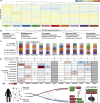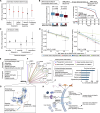Proteomic signatures of corona and herpes viral antibodies identify IGDCC4 as a mediator of neurodegeneration
- PMID: 40446030
- PMCID: PMC12124368
- DOI: 10.1126/sciadv.adt7176
Proteomic signatures of corona and herpes viral antibodies identify IGDCC4 as a mediator of neurodegeneration
Abstract
Mechanisms underlying the dynamic relationships of viral infections and neurodegeneration warrant examination. Using a community-based cohort of older adults, the current study characterized the neurocognitive (cognitive functioning, brain volumes, Alzheimer's disease positron emission tomography, and plasma biomarkers) and plasma proteomic (7268 proteins) profiles of four common coronavirus and six herpesvirus antibody titers. Genetic inference techniques demonstrated the associations between viral antibody titers and neurocognitive outcomes may be attributed to altered expression in a subset of mechanistically relevant proteins in plasma. One of these proteins, IGDCC4 (immunoglobulin superfamily deleted in colorectal cancer subclass member 4), was related to 20-year dementia risk, cognitive functioning, and amyloid-β positivity using data from two independent cohorts, while its plasma and intrathecal abundance were causally implicated in dementia risk and clinically relevant brain atrophy. Our findings illuminate the biological basis by which host immune responses to viruses may affect neurocognitive outcomes in older adults and identify IGDCC4 as an important molecular mediator of neurodegeneration.
Figures





References
-
- Duggan M. R., Peng Z., An Y., Kitner Triolo M. H., Shafer A. T., Davatzikos C., Erus G., Karikkineth A., Lewis A., Moghekar A., Walker K. A., Herpes viruses in the Baltimore Longitudinal Study of Aging: Associations with brain volumes, cognitive performance, and plasma biomarkers. Neurology 99, e2014–e2024 (2022). - PMC - PubMed
-
- Sipilä P. N., Heikkilä N., Lindbohm J. V., Hakulinen C., Vahtera J., Elovainio M., Suominen S., Väänänen A., Koskinen A., Nyberg S. T., Pentti J., Strandberg T. E., Kivimäki M., Hospital-treated infectious diseases and the risk of dementia: A large, multicohort, observational study with a replication cohort. Lancet Infect. Dis. 21, 1557–1567 (2021). - PMC - PubMed
MeSH terms
Substances
LinkOut - more resources
Full Text Sources
Medical

